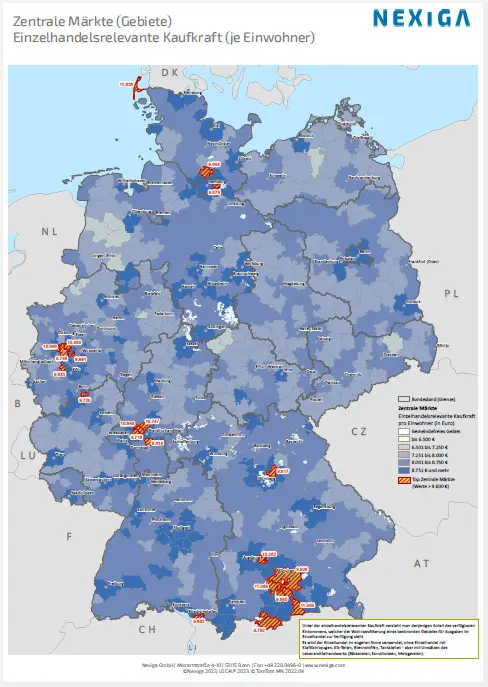There are currently 10,993 towns and municipalities in Germany. With their facilities and services - from public administration to various shopping opportunities - the cities also have certaincatchment areas. A wealth of market data is available toestimate customer potential(for service providers and retailers), from the number of inhabitants to purchasing power. However, consumption does not stop at the municipal boundaries.
Larger towns with a corresponding range of products and services are experiencing an influx of customers, while other towns are seeing anoutflow of customers and therefore also purchasing power. This so-called purchasing power retention is included in detail in the Nexiga market data portfolio.

Supply for the surrounding area
Depending on thesize of the retailoffer , jobs and infrastructure, many cities have a more or less central function in supplying their surrounding areas . State regional planning defines these levels of centrality and uses them as a control instrument in spatial planning. However, these spatial organization models are complex, and in particular they are not free of overlaps.
But how canmeaningful planning grids be createdfor the retail sector that, on the one hand, map the spatial relationships between centers and their surrounding areas and, on the other hand, clearly assign all municipalities and/or zip code areas to regional market areas? These territorial units are intended to structure the federal territory in a meaningful - i.e. market-oriented -way. The aim is to define regional units in which products are sold, e.g. via the retail trade.
Central markets as a pragmatic system for dividing up space
For this purpose, Nexiga has formed 830 "central markets"in Germany. The demarcation is comprehensive and non-overlapping.
This offers the advantage of practicability and more than compensates for the interdependencies in the vicinity of supra-regional centers, which are not always fully mapped. For example, the central market "Bonn" naturally also has an impact on suburbs such as "Königswinter" or "Wachtberg". Each "central market" has a central location (regional or medium-sized center) as the eponymous center and the neighboring municipalities assigned to this core. Retail, administration and, of course, many jobs are concentrated in the center. The neighboring municipalities usually form the (core) catchment area.
Aggregatable and independent
The individual central markets can be aggregated from the "building blocks"Municipality and zip code areas.
They are independent of County and national borders as well as postcode zone borders, as customer flows often cross administrative borders. Every central market has a central place(regional or medium-sized center) as the eponymous center and associated neighboring communities. Retail, administration and, of course, many jobs are concentrated in the center. The neighboring municipalities usually form the (core) catchment area.
The criteria for definingthe central markets are community typologies (centrality), purchasing power retention (retail sales in relation to retail-relevant purchasing power), commuter flows and the circulation areas of regional newspapers.
The map shows the retail-relevant purchasing power per inhabitant for 2023 in euros. In addition, the geographical submarkets were grouped into a total of27 structural area typesfrom "Metropolitan areas" to "Holiday areas east". The central markets thus provide bricks-and-mortar retailers in particular with a market area grid that already maps catchment areas and potential customer flows. Based on thecentral market typology, demand-oriented sales figures can be developed,sales evaluated and market opportunities assessed.

